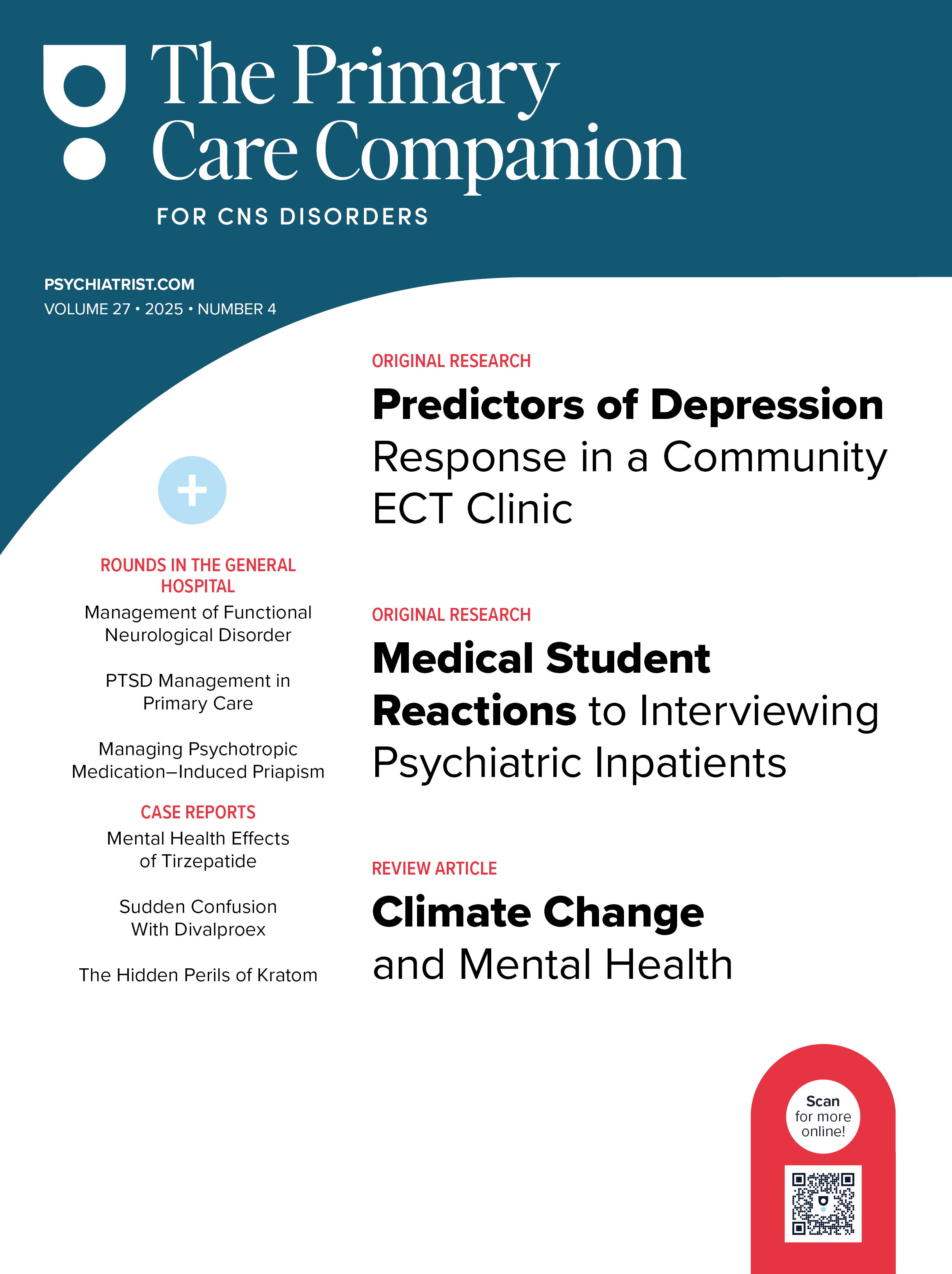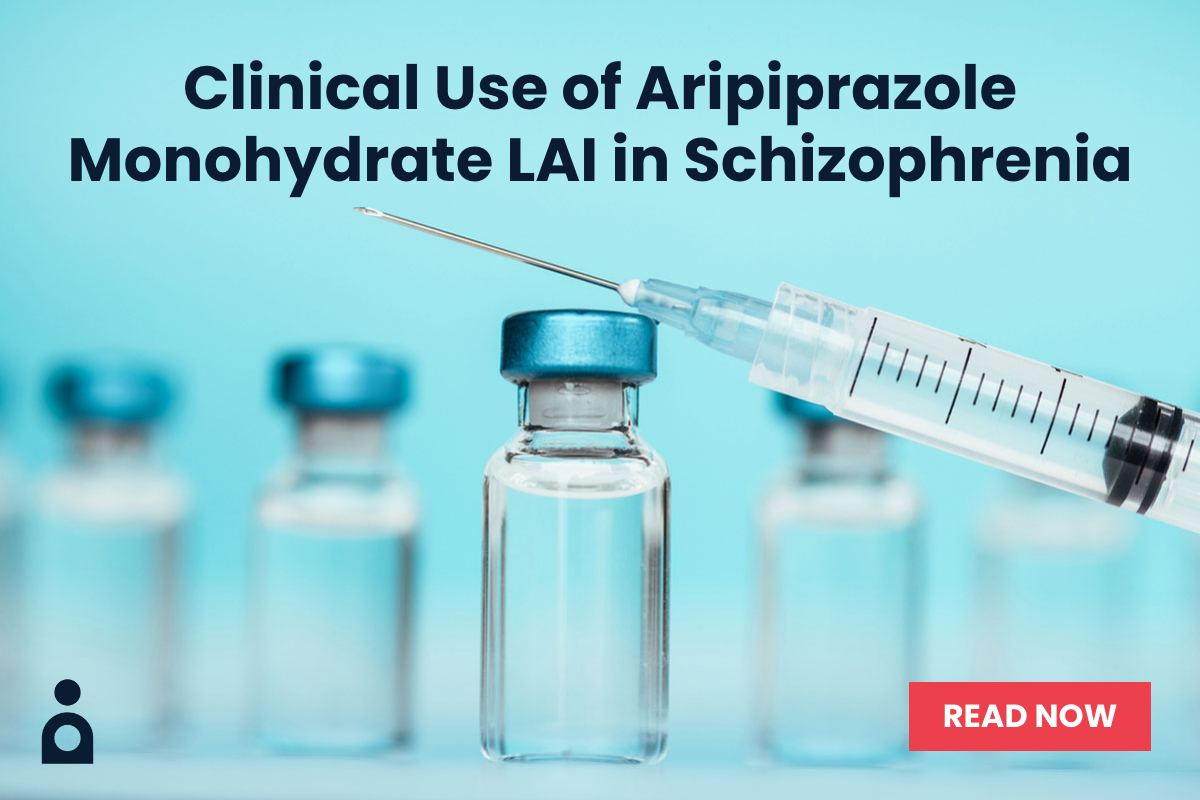
Encouraging a Nuanced Understanding of the Hopelessness-Suicidality Link
The "hopelessness theory of depression" was postulated over 40 years ago.1 Hopelessness depression was described as a subtype of depression with negative expectations at its core: those with negative expectations become hopeless and may subsequently develop suicidality because of cognitive vulnerability.2,3 Beck’s 4 cognitive theory of depression includes hopelessness as a central characteristic and an important link between depression and suicide. Hopelessness has been strongly associated with suicidal intent,5 and some have suggested that hopelessness was a stronger determinant of suicidal intent than depression.6,7
In our recent pilot investigation,8 women veterans were evaluated for suicidal ideation (SI), depression, and hopelessness, specifically during pregnancy and postpartum. We utilized a psychological assessment battery including the Beck Hopelessness Scale (BHS),9 the Columbia-Suicide Severity Rating Scale (C-SSRS),10 and the Edinburgh Postnatal Depression Scale (EDPS).11 Although we hypothesized that more severe hopelessness and depression would be related to SI, we found no correlation between hopelessness—as measured by the BHS—and SI. As expected, we did determine a positive correlation between hopelessness and depression.
Admittedly, our study sample was small and focused on a highly specific population,8 but our results paralleled those described in the recent publication by Baryshnikov and colleagues12: the severity of depression was a stronger predictor of SI than hopelessness. This finding is not surprising given that depression is a broad construct assessing cognitive, emotional, and behavioral aspects of functioning, whereas hopelessness is a narrow cognitive measure. Baryshnikov et al12 concluded that the role of hopelessness as a factor for SI in depressed individuals may have been overestimated, but several important considerations are worthy of discussion.
First, the term suicidality can be used to encompass SI, suicide intent, and suicide completion, but this aggregation can be misleading when describing research outcomes. Ideation can be passive, whereas intent and completion are active. As contemplation and enactment are inherently different, this distinction may be a critical differentiation when describing future research populations. Second, the BHS has been shown to be predictive of suicide completion,9,13,14 and hopelessness is an important component of multiple current suicide theories.15-18 However, it is possible that hopelessness as calculated by the BHS may differ from severity of depression or SI. Hence, the method of assessment for SI and hopelessness requires attention given variability observed with different assessments19-21 and patient populations.22-24
Researchers continue to investigate the hopelessness theory of depression25 and the significance of hopelessness for SI.26 Some investigators have asserted that other factors—such as anxiety or the severity of depression—may act as moderating factors of hopelessness and hence be driving factors for suicidal thoughts.12,27-33 Extant literature has robustly established hopelessness as a risk factor for suicide completion.4-7,9,13,14 In the future, researchers should differentiate suicidal thoughts or intent from completion to discriminate the impact of hopelessness.32,33 In contrast to Baryshnikov et al,12 we assert that hopelessness may yet prove to be a critical risk factor for SI, especially for depressed individuals, and we caution against disregarding its importance.
Published online: October 8, 2020.
Potential conflicts of interest: None.
Funding/support: Support was provided by Majda Foundation, VA Advanced Fellowship in Women’s Health, and VA CESAMH.
Role of the sponsor: The sponsors had no role in the design and conduct of the study; collection, management, analysis, and interpretation of data; or preparation, review or approval of the manuscript.
Disclaimer: All 3 authors are Federal employees who performed this work as part of their Federal job duties.
REFERENCES
1.Abramson LY, Metalsky GI, Alloy LB. Hopelessness depression: a theory-based subtype of depression. Psychol Rev. 1989;96(2):358-372. CrossRef
2.Abramson LY, Alloy LB, Hogan ME, et al. The hopeless theory of suicidality. In: Joiner TE, Rudd MD, eds. Suicide Science: Expanding Boundaries. Boston, MA: Kluwer Academic Publishing; 2000:17-32.
3.Minkoff K, Bergman E, Beck AT, et al. Hopelessness, depression, and attempted suicide. Am J Psychiatry. 1973;130(4):455-459. PubMed
4.Beck AT. Depression: Clinical, Experimental, and Theoretical Aspects. New York, Ny: Harper & Row; 1967.
5.Beck AT, Kovacs M, Weissman A. Hopelessness and suicidal behavior: an overview. JAMA. 1975;234(11):1146-1149. PubMed CrossRef
6.Bedrosian RC, Beck AT. Cognitive aspects of suicidal behavior. Suicide Life Threat Behav. 1979;9(2):87-96. PubMed
7.Wetzel RD, Margulies T, Davis R, et al. Hopelessness, depression, and suicide intent. J Clin Psychiatry. 1980;41(5):159-160. PubMed
8.Szpunar MJ, Crawford JN, Baca SA, et al. Suicidal ideation in pregnant and postpartum women veterans: an initial clinical needs assessment. Mil Med. 2020;185(1-2):e105-e111. PubMed CrossRef
9.Beck AT, Steer RA, Kovacs M, et al. Hopelessness and eventual suicide: a 10-year prospective study of patients hospitalized with suicidal ideation. Am J Psychiatry. 1985;142(5):559-563. PubMed
10.Posner K, Brown GK, Stanley B, et al. The Columbia-Suicide Severity Rating Scale: initial validity and internal consistency findings from three multisite studies with adolescents and adults. Am J Psychiatry. 2011;168(12):1266-1277. PubMed CrossRef
11.Cox JL, Holden JM, Sagovsky R. Detection of postnatal depression: development of the 10-item Edinburgh Postnatal Depression Scale. Br J Psychiatry. 1987;150(6):782-786. PubMed CrossRef
12.Baryshnikov I, Rosenström T, Jylhä P, et al. Role of hopelessness in suicidal ideation among patients with depressive disorders. J Clin Psychiatry. 2020;81(2):19m12866. PubMed CrossRef
13.Beck AT, Brown G, Steer RA. Prediction of eventual suicide in psychiatric inpatients by clinical ratings of hopelessness. J Consult Clin Psychol. 1989;57(2):309-310. PubMed CrossRef
14.Beck AT, Brown G, Berchick RJ, et al. Relationship between hopelessness and ultimate suicide: a replication with psychiatric outpatients. Am J Psychiatry. 1990;147(2):190-195. PubMed CrossRef
15.Klonsky ED, May AM. The three-step theory (3ST): a new theory of suicide rooted in the "ideation-to-action" framework. Int J Cogn Ther. 2015;8(2):114-129. CrossRef
16.Klonsky ED, Saffer BY, Bryan CJ. Ideation-to-action theories of suicide: a conceptual and empirical update. Curr Opin Psychol. 2018;22:38-43. PubMed
17.Rudd MD. Fluid Vulnerability Theory: A Cognitive Approach to Understanding the Process of Acute and Chronic Suicide Risk. Washington, DC: American Psychological Association; 2006:355-368.
18.Van Orden KA, Witte TK, Cukrowicz KC, et al. The interpersonal theory of suicide. Psychol Rev. 2010;117(2):575-600. PubMed CrossRef
19.Sokero TP, Melartin TK, Rytsälä HJ, et al. Suicidal ideation and attempts among psychiatric patients with major depressive disorder. J Clin Psychiatry. 2003;64(9):1094-1100. PubMed CrossRef
20.Sokero P, Eerola M, Rytsälä H, et al. Decline in suicidal ideation among patients with MDD is preceded by decline in depression and hopelessness. J Affect Disord. 2006;95(1-3):95-102. PubMed CrossRef
21.Vuorilehto M, Valtonen HM, Melartin T, et al. Method of assessment determines prevalence of suicidal ideation among patients with depression. Eur Psychiatry. 2014;29(6):338-344. PubMed CrossRef
22.Pfeiffer PN, Brandfon S, Garcia E, et al. Predictors of suicidal ideation among depressed Veterans and the interpersonal theory of suicide. J Affect Disord. 2014;152-154:277-281. PubMed
23.Valtonen H, Suominen K, Mantere O, et al. Suicidal ideation and attempts in bipolar I and II disorders. J Clin Psychiatry. 2005;66(11):1456-1462. PubMed CrossRef
24.Valtonen HM, Suominen K, Sokero P, et al. How suicidal bipolar patients are depends on how suicidal ideation is defined. J Affect Disord. 2009;118(1-3):48-54. PubMed CrossRef
25.Liu RT, Kleiman EM, Nestor BA, et al. The hopelessness theory of depression: a quarter century in review. Clin Psychol (New York). 2015;22(4):345-365. PubMed
26.Beck AT, Steer RA, Beck JS, et al. Hopelessness, depression, suicidal ideation, and clinical diagnosis of depression. Suicide Life Threat Behav. 1993;23(2):139-145. PubMed
27.Baryshnikov I, Rosenström T, Jylhä P, et al. State and trait hopelessness in a prospective five-year study of patients with depressive disorders. J Affect Disord. 2018;239:107-114. PubMed CrossRef
28.Wang YY, Jiang NZ, Cheung EF, et al. Role of depression severity and impulsivity in the relationship between hopelessness and suicidal ideation in patients with major depressive disorder. J Affect Disord. 2015;183:83-89. PubMed CrossRef
29.Keilp JG, Grunebaum MF, Gorlyn M, et al. Suicidal ideation and the subjective aspects of depression. J Affect Disord. 2012;140(1):75-81. PubMed CrossRef
30.Keilp JG, Ellis SP, Gorlyn M, et al. Suicidal ideation declines with improvement in the subjective symptoms of major depression. J Affect Disord. 2018;227:65-70. PubMed CrossRef
31.Bilgiç A, Yilmaz S, Herg×¼ner S. The impact of anxiety sensitivity on suicidality in adolescents with major depressive disorder. Psychiatr Danub. 2017;29(4):473-479. PubMed CrossRef
32.Klonsky ED, May AM, Saffer BY. Suicide, suicide attempts, and suicidal ideation. Annu Rev Clin Psychol. 2016;12(1):307-330. PubMed CrossRef
33.Burr EM, Rahm-Knigge RL, Conner BT. The differentiating role of state and trait hopelessness in suicidal ideation and suicide attempt. Arch Suicide Res. 2018;22(3):510-517. PubMed CrossRef
aDepartment of Veterans Affairs (VA) San Diego Healthcare System, San Diego, California
bVA San Diego Healthcare System Center of Excellence for Stress and Mental Health (CESAMH), San Diego, California
cUniversity of California, San Diego, California
*Corresponding author: Mercedes J. Szpunar, MD, PhD, Veterans Affairs San Diego, 3350 Villa La Jolla Dr, San Diego, CA 92161 ([email protected]).
Prim Care Companion CNS Disord 2020;22(5):20br02617
To cite: Szpunar MJ, Khalifian CE, Lang AJ. Encouraging a nuanced understanding of the hopelessness-suicidality link. Prim Care Companion CNS Disord. 2020;22(5):20br02617.
To share: https://doi.org/10.4088/PCC.20br02617
© Copyright 2020 Physicians Postgraduate Press, Inc.
Please sign in or purchase this PDF for $40.00.




